Rosina Lippi's Blog, page 18
July 7, 2015
Kerfuffle, Unlimited: Dear Author in Distress
I’m the first to admit that I’m out of the loop. I try not to spend a lot of time wandering in the ether; as a procrastination method, it’s excellent. And most writers really don’t need any more ways to procrastinate.
Having said this, a couple of comments left here and on my Facebook page made me curious, so I went in search of the things mentioned. And that’s how I ran into the whole Dear Author v. Ellora’s Cave Kerfuffle. And it is a Kerfuffle with a big, big K. I’m not going to go into all the details here (you can read about the whole mess here, here, here, or here) but to summarize:
1. Jane Litte of Dear Author wrote a post about Ellora’s Cave, a publishing house, summarizing everything she had learned about their less than ideal business practices and financial dealings. She was specific and detailed in some of her criticism.
2. Ellora’s Cave is suing Jane Litte and Dear Author. The lawsuit began in September 2014 and is still gaining steam. Initial reactions were very supportive of Jane’s position. Smart Bitches Trashy Books wrote about Jane’s situation and organized a legal fund.
 .3. In the course of discovery — where lawyers spend time researching the facts — the fact that Jane Litte is not only the primary mover behind Dear Author (with the phrase “for readers, by readers” placed prominently) and its approach to reviewing romance novels, she also has published romance novels under a pen name, something she didn’t reveal to her Dear Author readership until that fact became public by means of her deposition.
.3. In the course of discovery — where lawyers spend time researching the facts — the fact that Jane Litte is not only the primary mover behind Dear Author (with the phrase “for readers, by readers” placed prominently) and its approach to reviewing romance novels, she also has published romance novels under a pen name, something she didn’t reveal to her Dear Author readership until that fact became public by means of her deposition.
4. Jane Litte has written at great length and in detail about her decision to remain anonymous as a novelist. She remains convinced that it was the right decision, but openly acknowledges that some people will take exception.
5. A good number of people have taken exception, and loudly. Initial unconditional support for her plight became conditional in many quarters. Individual reasons for unhappiness about Litte’s non-disclosure are complicated.
So that’s it in a nutshell. Now, after thinking about all this for a couple days, I’d like to make a couple observations.
Litte’s position is that EC sued her in an effort to intimidate her, and curtail criticism. I agree with her that it’s important to defend the right to free expression and I hope that the court case would sort all that out in her favor. The issue of her writing novels anonymously while running a review site is a different matter.
Dear Author and Smart Bitches have both mentioned authors who responded with glee to the news that Litte was being sued. Both have been disdainful of the persons who have been openly gleeful.
This is where I need to point out something that has bothered me for a long time. I touched on it a few days ago in a post about negative reviews, but here it is more succinctly: Websites and website authors who provide reviews for any reading community have rights under the first amendment to the constitution that should be protected. But those same websites also foster a tone and atmosphere that is in no way protected, and I believe that some of the gleeful reaction to Litte’s situation has to do with that tone.
Litte spent ten years putting together a popular, well structured weblog about romance writers and novels.The set up was provocative, in that the reviewer was writing directly to the author. In a very short time Litte established herself as an arbiter of author behavior, and she did it vocally. Her readers did not challenge this assumption of authority; they supported her in it. One aspect of this was her habit of identifying authors whose behavior she didn’t approve of, and putting them on a public list called Authors Behaving Badly.
Full disclosure: None of my novels have been reviewed at Dear Author, so I am not resentful about a bad grade (but I do think the grading approach is questionable); Little did put me on that list in 2006 for defending a specific weblog review which was very critical of another author’s novel. I had no right to express this opinion, as she saw it.
Authors are always warned not to respond to negative reviews. Litte’s Authors Behaving Badly is a kind of meta review not of the author’s work, but of the author his or herself. It was really impossible to respond to Litte’s relegation of me to her list, without making the whole thing worse. And of course, she knew that. She knew that simply by putting an author on that list, she was tying hands.
The problem is far bigger than the Author Behaving Badly list. I wrote last week about the Cassie Edwards debacle that was started and promoted primary by Smart Bitches and Dear Author. The issue was not outing Edwards’s poor and unethical choices, which was in fact a public service. The issue was the tone. Authors and commenters seemed intent not just on exposing plagiarism, but also on shaming the author. The tone went from critical to cruel. My position is that the whole discussion should have remained neutral in tone, but of course, it wasn’t my call. I sat back and watched it all happen, the proverbial car crash.
Stop the Goodreads Bullies is a weblog run by anonymous readers, dedicated to identifying and stopping systematic bullying of authors on the internet, at Goodreads in particular. They have written a lot about Jane Litte, documenting some cases of her behavior which are questionable at best.
Litte has voiced very strong opinions on what’s right and wrong for authors, but didn’t stop to mention that she is herself an author; further, as an author she has done things that she has traditionally railed against.
When all of this is taken into account, the idea that there are authors out there who are gleeful about Litte’s being sued is less of a mystery.
JT’s comment regarding the Jane Litte non-disclosure summarizes my own take very closely.
edited to correct typos
Tweet

July 6, 2015
A Question for You – and an Excerpt
First, here’s the first paragraph of The Gilded Hour:
Early on a March morning on the cusp of spring, Anna Savard came in from the garden to find a young woman with a message that would test her patience, disrupt her day, and send her off on an unexpected journey: a harbinger of change wearing the nursing habit of the Sisters of Charity, standing in the middle of the kitchen.
And here’s the scene in which Anna and Jack first have a conversation. After that, there’s a question for you.
At the Vanderbilt Ball
[Anna] rose, interrupting a perennial argument about a poker game played years earlier, and excused herself. The simple truth was that if she did not have a quarter hour of solitude in the fresh air she would seal her reputation as an overeducated spinster unsuitable for company by falling asleep in the middle of the biggest social event of the decade.
It took a few minutes to find the right kind of hallway—one used by staff alone to reach the back of the house—and from there she found a door that led into an unoccupied courtyard enclosed by a limestone wall, lit dimly by a set of workroom or pantry windows. Here music and voices were reduced to an undercurrent of sound much like a mosquito shut in a nearby room, persistent but still possible to ignore. Oh, she was cranky. And for no good reason.
The space was half filled with bricks, lumber, nail kegs, a ladder, a pyramid of roofing tiles. Odder still, there were at least a dozen tall gardening buckets filled with roses of every color and shape. She took a deep cleansing breath that came to her to filled with shifting fragrances: apricot, heliotrope, honey, oak moss and vanilla, musk and myrrh.
She was far happier here in the dim quiet, but Cap had always loved fancy parties like this one, the more ridiculous the better. He would be laughing about them for weeks afterward. In good health Cap would be on the dance floor or chasing from room to room to examine a painting here or a tapestry there, telling stories and jokes and the riddles he was famous for. Emptying one glass of champagne after another as he went. Sweet- talking old women and their eligible granddaughters with equal ease.
It was Sophie who should have been here tonight with him. It was Sophie he loved, and who loved him, who knew him best. When Anna thought about the impasse between them she sometimes daydreamed about tying each of them to a chair and leaving them face-to-face until they remembered how to talk to each other.
They wanted to marry, but in the end Sophie couldn’t bear the thought of what such a marriage would do to Cap, and so she refused him again and again. Anna had the idea that if he were to ask now, Sophie would say yes; she missed him terribly, as he missed her. But he would not ask.
The scent of the roses was very strong despite the cool air, and Anna thought how sad that they should be out here, unappreciated. She could take Cap a rose, a single perfect rose, and let him read into that whatever message he might.
Behind her she heard the rough strike and flare of a match. A familiar noise, nothing extraordinary about it in the course of a normal day. She turned her head and saw that a man was leaning against the far corner of the courtyard wall. He lifted the cigar to his mouth and drew on it and Anna saw the round red cinder flare in the dark. He was dark complexioned, big, dressed not in a costume but in a conservative suit, and he was watching her. Deliberately, calmly, watching her and taking in her awareness of him and the alarm that rose on her skin like a rash.
“You needn’t fear me, madam. I’m Detective Sergeant Oscar Maroney of the New York Police Department.” His tone was pleasant, his voice slightly rough with tobacco. “Contemplating a bit of larceny? A rose or two, perhaps.”
Anna wasn’t easily flustered, but she was cautious by nature and unwilling to play games with a stranger, police officer or not. She turned and walked back to the door, which was opening even as she reached for the knob.
The man who stood in the doorway was just as tall as his counterpart, and together with the solid width of shoulder and chest he seemed as all-encompassing and absolute as a wall. And oddly, in one hand he held a peach, round and full and blush-colored even in the dim light. On the edge of spring, so odd that he might have held the moon itself in one cupped broad hand. Anna tore her eyes away, took one step back, and limited herself to three words, spoken calmly but with an iron core that could not be overheard: “Please step aside.”
“Dr. Savard,” said a familiar voice. “I didn’t expect to see you again so soon.”
Anna stopped just where she was, unsure but curious, too. Almost afraid to raise her eyes to the man’s face.
Detective Maroney said, “You didn’t make much of an impression, Jack. She doesn’t recognize you.”
Jack. That small hint was enough to make her look again, to take in the flash of a smile. Detective Sergeant Mezzanotte. Giancarlo. Jack.
“Is that so?” In one smooth movement Mezzanotte sent the peach sailing across the small courtyard, where his friend caught it in an upraised hand. Then he looked at her directly, a question in his gaze.
“I recognize you now,” Anna said. “You are dressed very differently than you were earlier today, Detective Sergeant.” He was dressed impeccably, in fact. A well-cut short-tailed jacket in the current style, a matching vest. The color could not be made out in the half light, but she thought it might be black. Nothing flamboyant, but something more elegant than she might have expected of a police detective, even one who worked in plain clothes.
Anna said, “You’re on duty?”
That overwhelming smile, again. She wondered if she still could smile herself, her face felt so oddly frozen.
He was saying, “When we met at the church I was coming from the greenhouses at home,” he said. “I was there over the weekend, and I spent the early morning trimming rose canes.”
He looked over her head to the roses, and she followed his gaze. He had said his parents were floriculturists, she remembered now.
“Those? Those are your roses?” She didn’t try to hide the doubt in her voice.
“Most of those are from Klunder’s nursery, but the very pale ones to the far right are ours. Cut yesterday, on Easter Sunday after sunset, brought in this morning before dawn.”
Because she was uncharacteristically at a loss for words, Anna said the first thing that came to mind. “How very wasteful. Mrs. Vanderbilt wanted every flower to be had, whether she could use them or not.”
Detective Maroney said, “Aha. That’s what my sister was on about.” Anna turned to look at him.
“She wanted flowers for the Easter dinner table, but there wasn’t a daffodil or a violet to be had, so she tells me, as if I plucked them all out of the ground and hid them to vex her. The best she could find was a single rose for a dollar and a half.”
“A dollar and a half,” Anna echoed, truly taken aback. “Our nursing students pay two dollars for a week’s room and board.” She realized that her tone was accusatory, but she found it impossible to sound otherwise. To Detective Sergeant Mezzanotte she said, “Is that right, a dollar and a half for a single rose?”
“No,” he said. “Or I should say, no honest florist would charge that much, but some will make the best of supply and demand. I can tell you that last week my uncle had to pay fifty dollars for a hundred General Jacqueminot roses.”
“Mrs. Vanderbilt pays such prices,” Anna said. “Her greed means Detective Sergeant Maroney’s sister had no flowers for her Easter table. She would have valued what Mrs. Vanderbilt squanders.” She sounded pompous to her own ears but seemed unable to govern what came out of her mouth.
Instead of responding, Jack Mezzanotte walked across the courtyard and crouched down for a moment. When he stood again he had a spray of three small rosebuds in one hand and a pocketknife in the other. He trimmed thorns from the stems as he came closer.
“Dr. Savard is right,” he said to his partner, though he kept his gaze fixed on Anna. “It is a shame for the roses to go to waste. Let me put at least a few to good use.”
He stopped in front of her, so close that she could feel the heat of him. One brow quirked up, as if to ask permission; Anna could have stopped him with a word or a raised hand. But she didn’t. She raised her face and looked at him to show that she was not intimidated or frightened or even embarrassed, and then she canted her head slightly. An invitation.
His attention was on her hair, one finger moving in a curve just over the silver hair clasp that Sophie had fixed there earlier this evening. Such a light touch, but she felt it moving down her spine in clear notes. Very gently he slid the stem into place, paused to consider, and moved it slightly. And then he stepped back and smiled at her.
“This rose is called La Dame Dorée. The breeder was trying to achieve the perfect white bourbon rose, but he didn’t succeed. When they open you’ll see that the inner petals are a very pale pink at the edge. The color isn’t perfect, but the scent is truly beautiful. And before you ask, we sell these wholesale, a hundred for ten dollars.”
He said, “I don’t know your first name.”
Her voice came hoarse. “Liliane. But I’m called Anna.”
There was nothing untoward in his expression or tone, and still she felt his regard. This morning she had been a different creature to him, only nominally female. That had changed, or more exactly, Countess Turchaninov had changed that. Anna found that this both irritated her and gave her a perverse pleasure.
She said, “Your hands will smell of La Dame Dorée all night.” Shocked at the impulse to put her face to his palm to test this assertion, she stepped away. “Pardon me, I have to go back to my friends.”
Then she slipped through the door into the hallway and out of sight. As soon as she had turned a corner she stopped and leaned against the wall to catch her breath.
Anna touched the rosebuds in her hair with a tentative finger, sure for one moment that she had imagined the whole odd encounter in the walled
courtyard.
Comments are welcome, but please don’t include spoilers in your comment out of respect for those who are spoiler-phobic. Which I’ll never understand. I personally adore spoilers.
QUESTION. So, I’m wondering if you can shed some light on this issue. I’ve set up this >>> very big giveaway <<<
Note: There is a poll embedded within this post, please visit the site to participate in this post's poll.
Tweet

July 4, 2015
Story Prompt & Win an ARC of The Gilded Hour
Exercise:
In a brief paragraph tell me about this ten year old girl: her name, where she lives, and the single most interesting thing about her.
There’s no right or wrong, just let your imagination fly. In a week’s time I’ll pull a name at random and that person will get one of the two The Gilded Hour ARCs that I have left. And remember, please, that there is a very big giveaway at the end of the summer, and any comment made between May 15 and September 1 is another entry for that drawing which includes:
A signed first edition of The Gilded Hour
Either a Kindle Paperwhite or an Amazon gift certificate of equal value
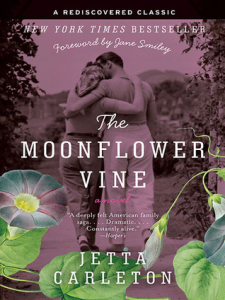 Three of my favorite novels either on the Kindle, or hardcopy
Three of my favorite novels either on the Kindle, or hardcopyThe Moonflower Vine
Lonesome Dove
Niccolo Rising
A professional manuscript evaluation (details here)
A copy of the Collector’s 20th anniversary edition of Outlander, signed by Diana Gabaldon (CD and all)
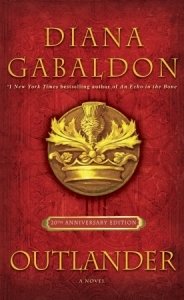 More good stuff, to be announced over the rest of the summer.
More good stuff, to be announced over the rest of the summer.
Tweet

July 1, 2015
Reviews: the good, the bad, the shaming
 Amy Impellizzeri has a piece today at Women Writers, Women’s Books which has me thinking hard. “Leave E.L. James Alone, Already” is a heart-felt appeal to writers not to join in when their colleagues are getting bashed.
Amy Impellizzeri has a piece today at Women Writers, Women’s Books which has me thinking hard. “Leave E.L. James Alone, Already” is a heart-felt appeal to writers not to join in when their colleagues are getting bashed.
The essay was born when she came across the #AskELJames thread on Twitter just recently. The thread became the subject of wider debate when a group of people with a complaint in common began to ask James pointed questions. From USA Today, this summary:
Shortly after the Q&A started on Monday afternoon, the #AskELJames hashtag was overtaken by Christian Grey haters who accused the author of being homophobic and misogynistic and romanticizing stalking and abuse. Others took issue with her actual writing, asking things like, “Which do you hate more, women or the English language?”
In response to this, Amy suggested that it’s never okay to voice a negative opinion about another writer’s work. She only posts a review if she can give it four or five stars:
Because books are art. And art is subjective. And art lays a soul bare. And who the heck wants to be responsible for stepping all over someone’s soul?
Well, certainly not me, thank you very much.
She suggests that we leave reviews to reviewers and keep writing. Her bottom line:
Don’t lie. Don’t be insincere. If you don’t like a book – especially from a fellow woman author – who would blame you for politely excusing yourself from the conversation?
Well, certainly not me, thank you very much.
Amy has a point, of course. But it seems to me she’s conflating a lot of very different issues.
Reviews come in all formats. Sometimes writers are asked to review books, sometimes they review books on their own websites or on sites like Goodreads. Reviews can be well done, or poorly done. More importantly: a positive review can be badly done, and a negative review can be well done. Here’s an example of a poorly done positive review: Great book! I loved it!!!
I would not call the E.J. James twitter thread a review. A thread that devolves into an exercise in bashing is an attack. It’s a bully-bullshit session. It’s an unworthy exercise, but unfortunately, it’s not uncommon.
There are a lot of bullies hanging around in the ether, and sometimes they join forces and form bands when they have a particular enemy in mind. The enemy can be a single individual, as was the case with the E.L. James twitter thread, or it can be a whole class of people. This happens in all kinds of fandoms. My daughter follows dance competitions and discussion online, and she has read me some truly disturbing bully-band attacks focused on one person who voiced a less-than-reverential comment about a performance by their favorite dancer. Personal attacks on an individual because that individual voiced a dissenting opinion.
It’s a phenomenon that somebody somewhere must be studying. At least, I hope someone is looking at it, because I see it as an example of the worst of human group behavior. But let’s be clear: everybody does it. Writers bash other writers, and on occasion, readers gang up on writers. Sometimes for good reason.
The best example I know of is the Cassie Edwards kerfuffle on Smart Bitches, Trashy Books and Dear Author. Wikipedia has the best summary of the situation I’ve come across, so I’m going to quote it here, with their links and footnotes intact:
On 7 January 2008, the romance-novel review blog Smart Bitches, Trashy Books[4] accused Edwards of widespread plagiarism after finding multiple passages in her novels that appeared to be directly taken from various works by other authors, including novels, poems, reference books, and websites about Native American history and culture.[1] Many of the passages came from old references, many without copyright or with expired copyright protection.[4][5] One of Edwards’ publishers, Signet, initially defended the passages in question as fair use rather than copyright infringement.[1]
Nora Roberts, herself a victim of plagiarism, joined the outcry.[6] Two days later, Signet announced that they would be reviewing all of Edwards’ books that they published to determine whether plagiarism had occurred,[7] and, in April 2008, Signet stopped publishing Edwards’ books “due to irreconcilable editorial differences.”[8] In an interview, Edwards said that she did not know she was supposed to credit sources, and her husband stated that Edwards gained ideas from her reference works but did not “lift passages”.[7]
On the surface I see nothing wrong with the fact that a group of readers discovered something unethical, and that they made those discoveries public. The author had no one to blame for the fallout but her own poor choices. At the same time, there was a gleeful tone in a lot of the discussion that made me uncomfortable. For example, a comment made on a Smart Bitches post in 2008:
So, let me get this straight: you were actually able to read an entire Cassie Edwards book while doing this research? You should apply to work on Mike Rowe’s Discovery Channel Program “Dirty Jobs.”
A negative review doesn’t have to be a shaming; a well-done negative review can leave an author with a new perspective. My work has received good reviews and constructive negative reviews and some mean-spirited reviews. The constructive negative reviews are probably the ones that do me the most good. The unreservedly good reviews I save for the occasional 2 a.m. crisis of the soul when I’m sure I have never written a single decent sentence. The stinkers I ignore, and sometimes if they are over-the-top, I can laugh at them.
Finally, when I do post a book review that is less than positive, I work very hard to be fair. It’s as close to a universal truth as you can come in this business to say that there are books for which I am (or you are) just not the right reader. I don’t write negative reviews very often, and I can remember only one instance when I was so infuriated by a novel that my tone bordered on outrage. But I will continue to write such reviews, now and then when I see a flaw in a book that strikes me as something worth talking about. A constructive discussion is a learning exercise for everybody.
——-
image: © altanaka – Fotolia.com found on an article well worth reading: Brené Brown Talks to The Shriver Report: The Power of Shame on Women Living on the Brink
Tweet

June 25, 2015
Kirkus reviews The Gilded Hour
And it’s a really good review.
This is especially good as Kirkus has not always been — shall we say — enthusiastic about my stuff in the past.
Another meticulously researched period drama with dashes of mystery and romance from Donati, this time set in 1880s New York. Donati (The Endless Forest, 2010, etc.) introduces two women doctors living near Washington Square during the Gilded Age: Dr. Liliane “Anna” Savard (granddaughter of Nathaniel Bonner of the Wilderness series) and Dr. Sophie Elodie Savard (Nathaniel’s great-granddaughter but about the same age as Anna). It’s 1883, and the doctors live with their Aunt Quinlan and her widowed stepdaughter, Margaret. Much of the story centers on the women’s work, and as the book opens, a young nun, Sister Mary Augustin, calls at their home for Sophie, who’s delivering a baby. Anna goes in her place to issue health certificates to a group of orphans. She meets DS Jack Mezzanotte and Rosa, an orphan trying to keep her sister and two brothers together. Donati spins the tales of Anna and Jack, Sophie and her maternity patient, the doctors’ childhood friend Cap Verhoeven, Rosa and her siblings, Sister Mary Augustin, and a plethora of friends and relatives into a story of more than 700 pages, all saturated with her signature historical detail. There’s good bit of social history, covering everything from “rational dress” and careers for women to contraception and the Comstock Act, advances in sanitation and public health. There are two mysteries as well, involving a serial killer preying on women seeking abortions and the whereabouts of Rosa’s brothers. Donati is skilled at giving depth to even the most minor characters, but she sometimes pursues tangents that are never fully explored. Despite the complexity, though, the novel never gets bogged down. Page-turning and atmospheric, Donati’s novel leaves readers with plenty of questions, perhaps signaling a sequel to come.
Tweet

June 23, 2015
Historical fiction: USA Today article
 Madeline Hunter not only writes great historical romances, she also has a column she writes for USA Today called HEA (Happily Ever After) about romance novels more generally. For today’s edition she interviewed a number of historical novelists (including me) about the difference between historical fiction and historical romance (you can read it here).
Madeline Hunter not only writes great historical romances, she also has a column she writes for USA Today called HEA (Happily Ever After) about romance novels more generally. For today’s edition she interviewed a number of historical novelists (including me) about the difference between historical fiction and historical romance (you can read it here).
It was very interesting to me to see how other writers (including Donna Thorland, whose novels I really like and I have been meaning to review) answered some very thought-provoking questions.
Tweet

June 20, 2015
Official Website
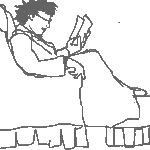 You’ve stumbled across my official website and landed on the front page of my weblog. If you’re interested in the Wilderness series, other novels or published work or what’s coming next, the menu above will take you just about anywhere you might want to go. Except New-York prior to 2015. That’s one leap I haven’t figured out yet.
You’ve stumbled across my official website and landed on the front page of my weblog. If you’re interested in the Wilderness series, other novels or published work or what’s coming next, the menu above will take you just about anywhere you might want to go. Except New-York prior to 2015. That’s one leap I haven’t figured out yet.
Tweet

June 18, 2015
Scoundrels: Read All About ‘Em
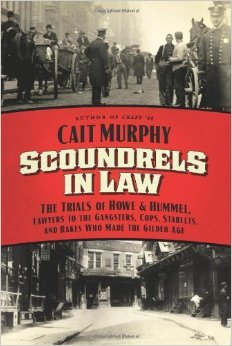 It seems that there have always been high-profile, less-than-virtuous lawyers around. In the 1880s in Manhattan, the firm of Howe & Hummel were probably the most prominent and outrageous of the legal scoundrels plying their trade.
It seems that there have always been high-profile, less-than-virtuous lawyers around. In the 1880s in Manhattan, the firm of Howe & Hummel were probably the most prominent and outrageous of the legal scoundrels plying their trade.
Cat Murphy’s book on these two upstanding citizens is the kind of non-fiction reading that keeps me up until two. In a review of Murphy’s book, Old Salt Books summarizes:
The partners bestrode Gilded Age New York with wit and brio, and everyone from Theodore Roosevelt to Lola Montez had a part in their story. In Howe & Hummel’s prime, it would not have been unusual to see a leading politician, a pickpocket, a Broadway star, a bank robber, and a socialite all crowded together into the waiting room of their offices, located conveniently across the street from the city jail.
To get the full picture of these men, their manner of practicing law, and their view of the world, it would be a good idea to read the book they wrote about the city where they lived and worked. It’s in the public domain and can be read on-line in a number of places, including Gutenberg.org.
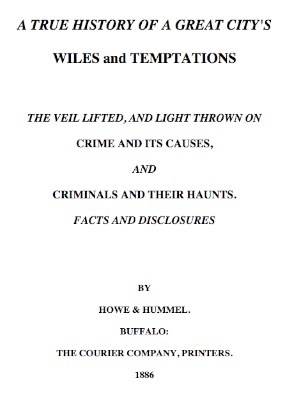 I read Danger! because it provides insight into the way the wealthy thought about poverty and the poor. Whatever amusement you may get from the antics these two pulled in courtrooms is offset by the way they described homeless girls as deviant criminals, motivated by greed and loose morals:
I read Danger! because it provides insight into the way the wealthy thought about poverty and the poor. Whatever amusement you may get from the antics these two pulled in courtrooms is offset by the way they described homeless girls as deviant criminals, motivated by greed and loose morals:
It is safe to say that very few of the flower girls were virtuous. They remained out until all hours of the night and plied a double trade, selling both their flowers and themselves. There was one well-known house in Thirteenth street which these little girls made a headquarters. It was between Broadway and University place. The proprietress had no other “ladies” but flower girls, as she found them more profitable, charged them higher prices for accommodations, whether by the day or week, and as but few places would assume the risk of harboring the waifs, they were compelled to pay her extortionate rates.

1880s Child Prostitute. Source unknown.
Some time since a man could hardly pass along Fourteenth street or Union Square, at night, without his being accosted by one of these girls, who, instead of asking him to purchase flowers, would invariably remark, “Give me a penny, mister?” by which term, afterwards, all these girls of loose character were known to ply their trade. Many of these girls were so exceedingly handsome as to be taken by gentlemen of means and well cared for, and one instance is known where a flower girl married a very wealthy man of middle age.
As a class, they were excessively immoral. They purchased their flowers, out and out, from the florists and made handsome profits, amounting to as much as two and three dollars a night when the weather was fine; but their habits and immoralities became so patent that the societies put a stop to their selling, by sending some to the House of the Good Shepherd, and arresting others for soliciting and other unlawful acts; so that to-day it is very much to be doubted if there are more than half a dozen in the city.
Both Howe and Hummel ended up on the wrong side of the law at various times. Hummel was disbarred at least twice, and Howe had a similarly checkered career.
Tweet

June 16, 2015
Manhattan 1892 – Medieval Style, via the Sun
It’s no secret that I have a terrible weakness for maps. Today I came across The Sun’s Guide to New York (1892), which is stuffed to the gills with fantastic maps of the kind you often see in very old manuscripts. Not quite to scale, some but not all buildings done in something approximating three dimensions, lots of things labeled. Now, 1892 is a little late for the novels I’m working on, but these maps are too good to pass over.
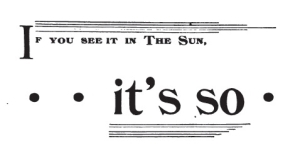
Sun Newspaper, New York ad 1892
There are about ten sets of two-page maps. Below is the first one (click for the full size image), of the southern most part of Manhattan. You’ll note that the Statue of Liberty is on this map, but she wasn’t there in 1883 (which is when The Gilded Hour is set). There are a lot of other differences between 1883 and 1892, but all in all these maps are extremely useful.
The Sun was one of the city’s major newspapers in this time period. Lots of self-referential advertising in the volume, which is a whopping 540 pages long. I’m going to see if I can locate a hard copy so I scan the maps at a high resolution.
Am I entirely alone in my delight with this?

Sun’s Guide, Lower Manhattan 1892 – click for full size version
Tweet

June 11, 2015
Meet Elizabeth Middleton Bonner’s Granddaughter, Anna
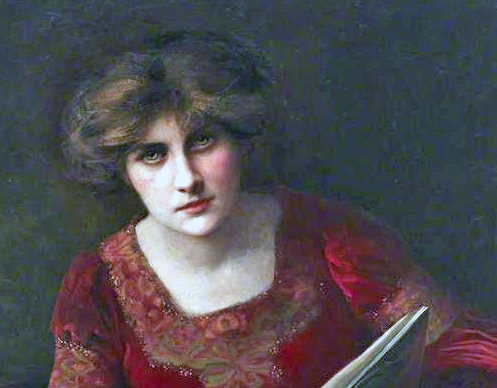
Beatrice Offor, British artist, and primary physical model for Anna
There are two primary female characters in The Gilded Hour, both granddaughters/great-granddaughters of Nathaniel Bonner.
Anna Savard is also Elizabeth’s granddaughter, while Sophie Savard (who you will meet later) is the granddaughter of Hannah and Ben Savard.
Here’s a short (no spoiler) introduction to Anna.
Tweet




